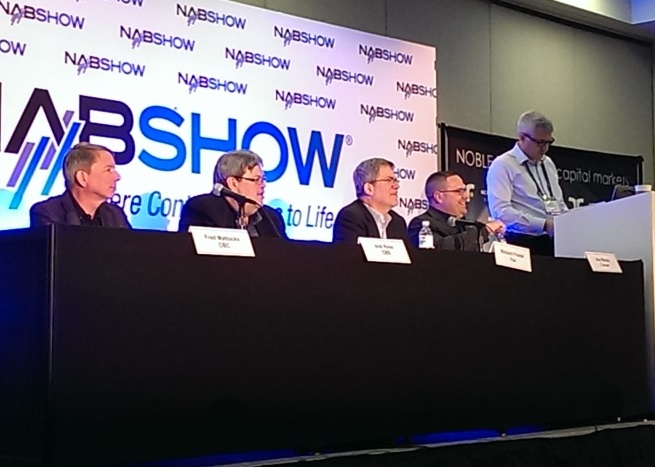
LAS VEGAS – As the march to a fully IP world continues unabated and video competition from all quarters intensifies, broadcasters around the world are increasingly turning away from upgrading to new proprietary hardware and systems in favour of software-driven, in-the-cloud services, searching for lower costs and improved efficiency (not to mention fewer people).
That was the message delivered by broadcasters and vendors Sunday during panel sessions at a media finance and investors conference which is part of the National Association of Broadcasters 2015 Convention happening here in Las Vegas.
Research company Devoncroft annually publishes a survey of broadcasting suppliers for the International Association of Broadcasting Manufacturers dubbed the Big Broadcast Survey where the company discerns trends in the business by interviewing more than 3,000 vendors representing more than US$48 billion in revenues.
According to Devoncroft principal analyst Josh Stinehour, there has already been a structural shift among broadcasters “where they are no longer just buying dedicated infrastructure just to make sure stuff looks good on TV sets.” Instead, they want cheaper, future-proofed, off-the-shelf hardware, married to specialized services, that will let them produce and serve video for any screen.
Devoncroft president Joe Zaller showed some of the 2014 survey’s data which, while still revealing decent annual sales growth of 2.9% from 2009-2014, software and services sales are what’s powering it as hardware sales have dipped. No one is doing forklift rebuilds anymore.
On the vendor’s panel, there was some disagreement over what the pace of change is now and how fast a complete conversion to IP will take place, with Imagine Communications (formerly Harris) and Harmonic predicting a quicker shift than the Belden and Quantel/Snell representatives. Imagine’s CEO Charlie Vogt reminded the audience he spent 15 years in the telecom world (mostly with Genband) and noted the IP shift there started slowly and then changed very quickly – and now no one is investing in legacy networks.
So, Imagine began investing heavily 18 months ago in virtualized workflow and coming up with solutions for broadcasters to move some of their network and storage into the cloud.
Harmonic’s CEO Patrick Harshman, whose company earns half of its revenue in the cable space, told the audience that changes might be happening slowly now, but once companies see the efficiencies in it “I’ve seen the shift happen really fast.” There used to be thousands of cable headends all around North America, for example, but many of those have been eliminated, thanks to fibre and IP transport.
“There’s big demand for knowing you can be 4K, but I’m not sure there’s a demand for 4K.” – Tim Thorsteinson, Quantel/Snell
Quantel/Snell CEO Tim Thorsteinson predicted a slower change, remembering an executive who told him more than a decade ago this type change was coming and the industry had to stop making things like baseband production switchers. If they had, they would have lost out on hundreds of millions in sales of the legacy products.
And when it comes to 4K broadcasting? Will broadcasters invest in yet another new upgrade? The vendors aren’t so sure, but they are ready. “There’s big demand for knowing you can be 4K, but I’m not sure there’s a demand for 4K.”
In the broadcasters panel, they confirmed the push for workflow efficiencies in order to drive costs from their systems as advertising revenues go elsewhere.
“When we make that decision that something needs to be replaced, we ask if that equipment is something we can purchase as a service instead,” said Ken Brady, SVP media technology and operations, Turner Broadcasting. He noted the company and CBS turned to Elemental Technologies, which provides cloud as a service, for help with serving video to places like buses during March Madness.
This type of flexibility, or the ability to “burst” with outside service suppliers during high-profile events means cost-savings to broadcasters who don’t have to buy gear which goes into service only once or twice a year. “Being able to expand and contract during that kind of (event),” is very handy, added Bob Ross, SVP east coast operations for CBS Broadcasting – especially when the company is encoding the video for dozens of different devices.
Added Fred Mattocks, the CBC’s general manager of media operations and technology, he looks regularly to buy “the necessary minimum, renting infrastructure” when needed and “bursting out,” for certain events.
However, what Mattocks says he spends most of his time thinking about is people and how they work – to try and maximize their content producing capabilities. “We want to utilize the functions and the equipment and also the people to their utmost,” he said.
“It will move along much faster than everyone thinks because we can’t afford not to.” – Fred Mattocks, CBC
“All the little inefficiencies add up every day… I don’t want to take a creative person and stop them from being creative for 10 minutes. That drives me nuts.”
While noting that there are only so many people that can be cut because it is those creative types who produce the content viewers turn to CBC to watch, an all-IP future and the further efficiencies it will bring is an unstoppable train, said Mattocks.
“Nobody knows what’s going to happen obviously, but the business pressures were all dealing with are so strong and if the promise of IP and IP infrastructure turns out to be realizable, it will move along much faster than everyone thinks because we can’t afford not to.”



